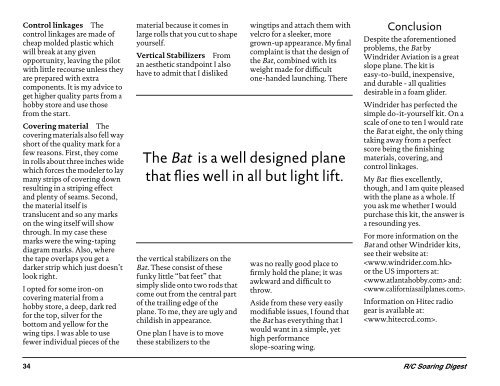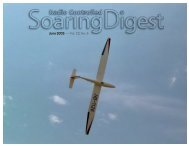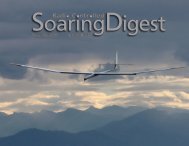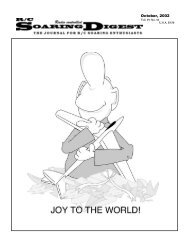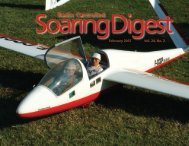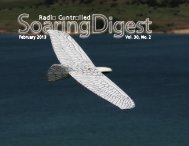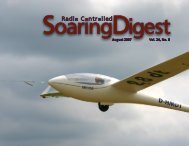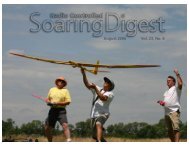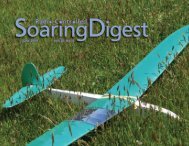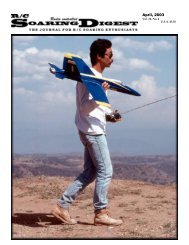December 2005 — Vol. 22, No. 12 - RC Soaring - RCSoaring.com
December 2005 — Vol. 22, No. 12 - RC Soaring - RCSoaring.com
December 2005 — Vol. 22, No. 12 - RC Soaring - RCSoaring.com
You also want an ePaper? Increase the reach of your titles
YUMPU automatically turns print PDFs into web optimized ePapers that Google loves.
Control linkages The<br />
control linkages are made of<br />
cheap molded plastic which<br />
will break at any given<br />
opportunity, leaving the pilot<br />
with little recourse unless they<br />
are prepared with extra<br />
<strong>com</strong>ponents. It is my advice to<br />
get higher quality parts from a<br />
hobby store and use those<br />
from the start.<br />
Covering material The<br />
covering materials also fell way<br />
short of the quality mark for a<br />
few reasons. First, they <strong>com</strong>e<br />
in rolls about three inches wide<br />
which forces the modeler to lay<br />
many strips of covering down<br />
resulting in a striping effect<br />
and plenty of seams. Second,<br />
the material itself is<br />
translucent and so any marks<br />
on the wing itself will show<br />
through. In my case these<br />
marks were the wing-taping<br />
diagram marks. Also, where<br />
the tape overlaps you get a<br />
darker strip which just doesn’t<br />
look right.<br />
I opted for some iron-on<br />
covering material from a<br />
hobby store, a deep, dark red<br />
for the top, silver for the<br />
bottom and yellow for the<br />
wing tips. I was able to use<br />
fewer individual pieces of the<br />
material because it <strong>com</strong>es in<br />
large rolls that you cut to shape<br />
yourself.<br />
Vertical Stabilizers From<br />
an aesthetic standpoint I also<br />
have to admit that I disliked<br />
the vertical stabilizers on the<br />
Bat. These consist of these<br />
funky little “bat feet” that<br />
simply slide onto two rods that<br />
<strong>com</strong>e out from the central part<br />
of the trailing edge of the<br />
plane. To me, they are ugly and<br />
childish in appearance.<br />
One plan I have is to move<br />
these stabilizers to the<br />
wingtips and attach them with<br />
velcro for a sleeker, more<br />
grown-up appearance. My final<br />
<strong>com</strong>plaint is that the design of<br />
the Bat, <strong>com</strong>bined with its<br />
weight made for difficult<br />
one-handed launching. There<br />
The Bat is a well designed plane<br />
that flies well in all but light lift.<br />
was no really good place to<br />
firmly hold the plane; it was<br />
awkward and difficult to<br />
throw.<br />
Aside from these very easily<br />
modifiable issues, I found that<br />
the Bat has everything that I<br />
would want in a simple, yet<br />
high performance<br />
slope-soaring wing.<br />
Conclusion<br />
Despite the aforementioned<br />
problems, the Bat by<br />
Windrider Aviation is a great<br />
slope plane. The kit is<br />
easy-to-build, inexpensive,<br />
and durable - all qualities<br />
desirable in a foam glider.<br />
Windrider has perfected the<br />
simple do-it-yourself kit. On a<br />
scale of one to ten I would rate<br />
the Bat at eight, the only thing<br />
taking away from a perfect<br />
score being the finishing<br />
materials, covering, and<br />
control linkages.<br />
My Bat flies excellently,<br />
though, and I am quite pleased<br />
with the plane as a whole. If<br />
you ask me whether I would<br />
purchase this kit, the answer is<br />
a resounding yes.<br />
For more information on the<br />
Bat and other Windrider kits,<br />
see their website at:<br />
<br />
or the US importers at:<br />
and:<br />
.<br />
Information on Hitec radio<br />
gear is available at:<br />
.<br />
34 R/C <strong>Soaring</strong> Digest


